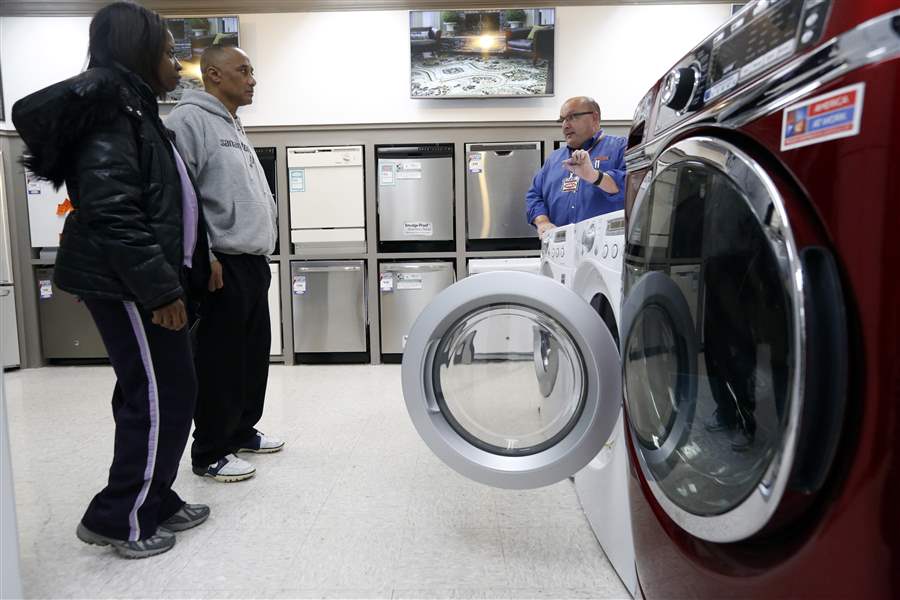
COMMENTARY
Ground-floor laundry room is a safe decision
9/8/2018
Customers view a washer and dryer at the Appliance Center in Maumee in 2015.
The Blade
Buy This Image
Finding room for and installing a washer and dryer on the first floor of the little green bungalow was the smartest move I have made since moving in three years ago.
Even as I write this I can hear the new appliance churning away in the other end of the house. I don’t want to believe that laundering is a new hobby, but the convenience has inspired more frequent washings.
The main-floor access lessened the chance of falling down the steep basement stairs. The horror stories of seniors breaking hips and other bones is one reason I opted for the transition, even though I have made it this far without even a broken fingernail. So why not take every precaution to keep that record going?

Powell
The advice doesn’t only apply to seniors, but everyone. You don’t have to be a certain age to fall, though statistics prove the chances are greater for seniors.
The addition of the new laundry appliances into an already crowded hallway in the 1920 house was not easy for me or for Keith Heising from Delta, the handy dandy carpenter I have come to depend on. I hate to admit that he was the second person hired to do the plumbing for the appliances. The first guy, who had been recommended by an appliance store, but who will not be named, charged $500 to prepare the hallway for a stacked unit. Without my knowledge he used parts from the perfectly good washer and dryer in the basement. The result was a good lesson learned and $500 down the drain, to turn a phrase, and tearing out what had been done. Add to that the extra expense to have the basement washer and dryer returned to working order with new parts.
So why does one person living alone need two washers and dryers? The answer: The basement appliances were kept to wash larger items such as rugs, blankets, bedspreads, and cat beds, because most stacked models are so small.
But, as it turned out, the luck of the Irish was on my shoulder the day I returned to Lowe’s on Airport Highway to spend about $1,800 on a compact unit with limited capacity.
Fortunately the same nice guy waited on me and announced with great pride that I was in luck. A full size double unit had been returned the night before by customers who learned that it was too big for the closet they had planned for it.
The markdown ticket was $600. The handsome Whirlpool quickly had a new buyer.
Making room in the hallway for the full-size equipment meant sacrificing an original storage cupboard that measured 30 by 36 inches and was 8 foot high. That the floor-to-ceiling deep cupboard was packed is an understatement. There still isn’t room for some of the pots and pans.
Hearing the workmen tear the old cupboard from its nearly 100-year plaster backbone was not all joyful. The cupboard not only was made of heirloom bead board, to match the walls, but was decorated with colorful flowers and birds by an artist using acrylic paint, 50 or more years ago. Yes, the cupboard pieces, including the doors, are in the basement. You just never know when you might need them.
An ode to something as basic as a washer and dryer stirs memories of laundry days, back in the day.
Doing the laundry was far from pushing control buttons and trusting automatic timers.
I still have the wooden stick that we used to pull the wet clothes from the washer to put into the rinse tub. The next step was transferring the wet laundry to move smoothly through the hand-driven roller.
A wooden rack that was designed to hold two rinse tubs and two rollers was one of my mother’s laundry day treasures because the double equipment cut her time in half.
But, as a child learning to make pie crust I saw it as an expedient way to roll pie dough through the rollers and eliminate the rolling pin. The experiment ruined the rollers. I doubt that I was punished, but I am sure I didn’t try it on the second rollers.
Monday was wash day, and it didn’t matter what the weather was. Monday was still the day to gather the dirty clothes, bedding, and whatever else needed to be washed.
Mondays in summer were a breeze when the sunshine and air truly did make things smell better. Air drying still is beneficial for the few families who have drying lines that once were as common in the backyard as the lawn.
Mondays in winter were dreaded. And of course, it seemed like the worst weather of the whole week was on Mondays.
But, no matter, mother said, the washing has to hang outdoors to get fresh and have that wonderful smell. So dutifully we hung the wet laundry on the long lines in the morning and in late afternoon went back into Artic temperatures, wearing gloves to gather the washing which was frozen stiff; so stiff that it wasn’t easy to bend to fit into the baskets.
Indoors it was a challenge of where to dry the frozen pieces of laundry, which ranged in size from stockings to sheets. The rooming house where I grew up had several heat floor registers. The system was to put a chair on each register, drape the laundered items over the chairs, and turn the furnace on high. Sooner or later — mostly later — things got dry. At grandma’s farmhouse the only heat was a big-bellied wood stove. She did have a folding drying rack to put near the stove for small items, but the big things were taken to the attic to dry.
Is it any wonder that when I hear the chic dryer humming in the back hall that it’s music to my ears?
Mary Alice Powell is a retired Blade food editor. Contact her at: poseypowell@aol.com.